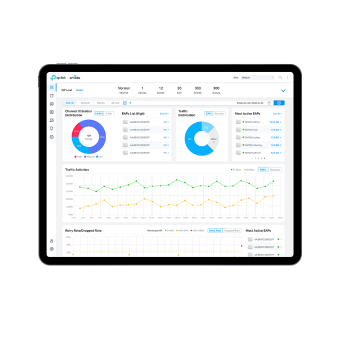How to Configure Portal Authentication on Omada Controller
Suitable for: Omada Controller V4.1.5 or above and EAP products with corresponding firmware.
Portal authentication is a kind of access authentication method, which is also known as web authentication. With portal function configured on Omada Controller, when a wireless client connects to an EAP managed by Omada Controller and tries to access the internet, it will be directed to a pre-set web page which requires additional authentication information. Only the wireless client which has the right authentication information can pass the web authentication to access the internet.
Portal authentication is suitable for managing wireless access in public places such as hotels, malls, airports and so on. It provides flexible method to control the connections to the network and vivid customized authentication portal page for business promotion.
The following gives some instructions on how to configure the portal authentication on Omada Controller.
Step 1. Run Omada Controller
Start Omada Controller software and login to the management page. For how to install and login to Omada Controller, please refer to User Guide of Omada Controller Software
Note: Please keep the controller running when you use portal authentication.
Step 2. Choose Appropriate Portal Authentication Type
1. Go to Authentication > Portal and click  to create a new portal. Specify a name and select the SSIDs for the Portal.
to create a new portal. Specify a name and select the SSIDs for the Portal.

2. Choose one of the five authentication methods. These authentication methods are available: No Authentication, Simple Password, Hotspot, External RADIUS Server, and External Portal Server.

- With No Authentication configured, all wireless clients connected to EAP devices will have access to internet without any authentication. But clients will still see the pre-set login page.

- With Simple Password configured, all wireless clients will use this single password for authentication.

- With this Hotspot configured, clients can access the network after passing any type of the 5 authentication: Voucher, Local User, SMS, RADIUS, Form Auth.

Voucher
Clients can use the unique voucher codes generated by the controller within a predefined time usage. Voucher codes can be printed out from the controller, so you can print the codes and distribute them to your costumers to tie the network access to consumption.
Local User
Clients are required to enter the correct username and password of the login account to pass the authentication.
SMS
Clients can get verification codes using their mobile phones and enter the received codes to pass the authentication.
RADIUS
Clients are required to enter the correct username and password which are stored in the RADIUS server to pass the authentication.
Form Auth
Clients are required to fill in a survey created by the network administrator to pass the authentication. It can be used for collecting feedback from your clients.
- If you have a RADIUS server, you can configure External RADIUS Server. With this type of portal, you can get two types of portal customization: Local Web Portal and External Web Portal. The authentication login page of Local Web Portal is provided by the built-in portal server of the controller. The External Web Portal is provided by external portal server. Enter the authentication login page’s URL provided by the external portal server in the External Web Portal URL field.

- The option of External Portal Server is designed for the developers. They can customize their own authentication type like Google account authentication according to the interface provided by Omada Controller.

Step 3 Customize the Portal Page
In the Portal Customization section, customize the Portal page including the background picture, logo picture and so on.

And you can select whether display advertisement pictures for users and configure the related parameters in the Advertisement section.

Notes:
- The maximum image size of the background and logo picture is 2MB. The supported formats are .jpg, .bmp, .gif, .png, .jpeg.
- Remember to click the
 after completing all the portal configurations.
after completing all the portal configurations.
Is this faq useful?
Your feedback helps improve this site.
TP-Link Community
Still need help? Search for answers, ask questions, and get help from TP-Link experts and other users around the world.
_normal_20231207104125v.png)

